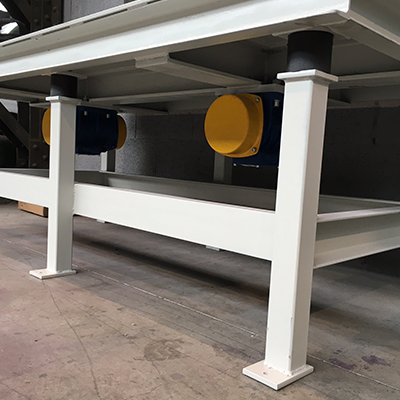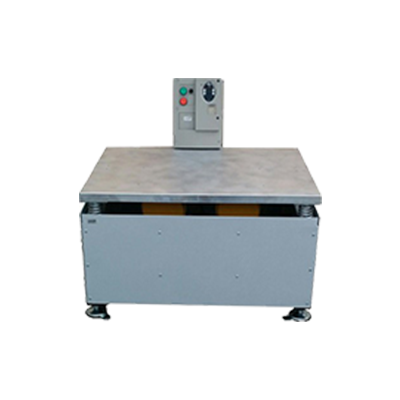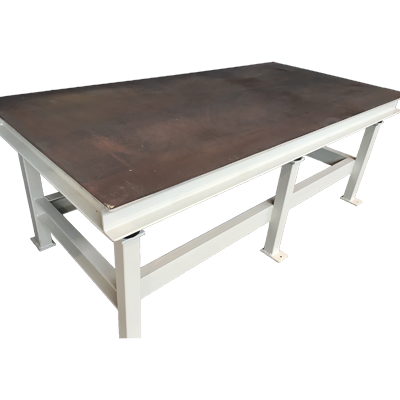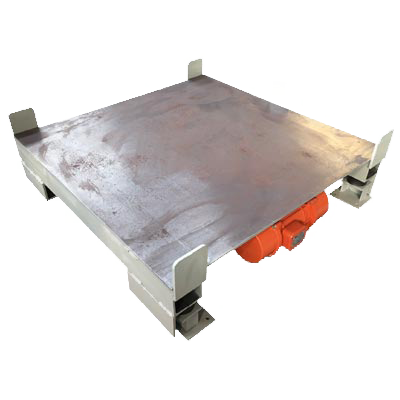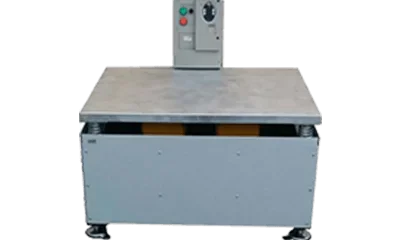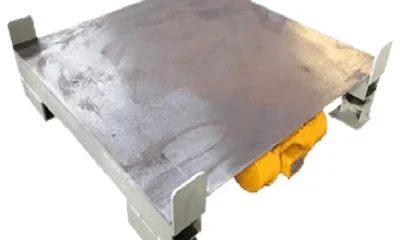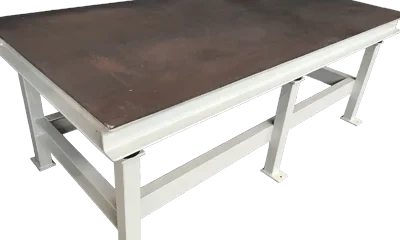
You need a vibrating table that is perfectly adapted to your applications? Contact us now to receive more details on our tailor-made vibrating tables options. Industrial vibrating tables are used in the industry to:
- Compress matter so as to optimize the load of a specific volume,
- Ensure a proper pouring of viscous matter into a mold,
- Vacuum the air out from the desired matter to improve its sturdiness and appearance,
- Test vibrations to optimize packaging for conveying purposes.
What are the main features of a vibrating table?
- A vibrating table is comprised of a vibrating tray, on which industrial vibrators are rested. The vibrating tray must imperatively be isolated from its body with rubber bushings or springs.
- The vibrator, attached to the tray, transmits the vibrations. (/1 vibrator: multidirectionnal vibrations /2 vibrators: unidirectional vibrations – if they rotate in opposite directions, a phase can be reversed).
Recommandations before conception
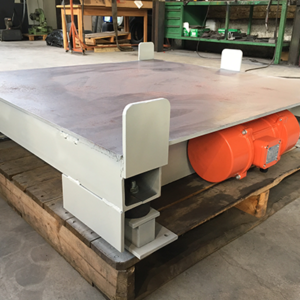
For instance, our 500 x 500 mm vibrating tables have a 20 mm thick metal tray fixed to a 40 x 40 tubular chassis, and is isolated from the latter by rubber bushings.
Bigger vibrating tables have sturdier trays, reinforced by a frame composed of “U” shaped devices – tilted towards the edges of the table, as well as “I” shaped crossties (in both length and width).
We then weld the tray to this plant, while the vibrators is fixed to connector boards, soldered to each “I” shaped crossings under the tray.
It is crucial that the welding procedure is executed with great care, in order to avoid deforming the tray or the connector boards – in this specific case, ban continuous welds.
Note that the vibrating table must be perfectly planar.
How does a vibrating table work?
- A vibrating table is provided with industrial vibrators. They are specially sized to match the following features: weight and dimensions of the table, weight of the load you wish to vibrate, characteristics of the material, and the mold.
- When they reach 3,000 rpm, the vibrators operate at a frequency (Hz) of 50 hz. A variable-frequency drive (VFD) can affect the frequency so the vibrators rotate at a speed of 1,500 to 4,500 rpm. Should you need to change the frequency from 50 to 75 hz, you have to make absolutely sure that the centrifugal force of the vibrators is at its lowest (20%), or to remove the eccentric weights from each side of the vibrators. Otherwise, the frequency will increase exponentially, which may damage your devices.
When using the table, it is also crucial that you pay attention to the amperage of the vibrators: if the amperage of the vibrator is above the recommended limit (as indicated in the datasheet), it means that the vibrating table is not sturdy enough and/or that the vibrators are not properly attached. In any case, vibrators must be connected to a thermal protection: should the amperage of your devices be too high, the power will disconnect.
To connect your vibrators to the correct cable cross-section, please check the installation guideline, which you can download here.
The table transmits vibrations to the mold through direct contact. Those molds must be made of metal; their contact surface must be as large as possible and perfectly planar.
Check our catalog to find out what vibrating table best fits your application, or contact us now to receive more details on our tailor-made vibrating tables options.
Many French companies already trust our expertise in vibrating tables making :
- Hd distribution: specialized in packaging, unpacking and storage of industrial powdered materials. 1200 x 1200 vibrating table created for Bigbag compatcing (1.5 T).
- Ionisos: service provider for treatment of ionizing radiations. 600 x 600 vibrating table created for Bigbag compatcing (1.5 T).
- Bostik: Vibrating table designed for compacting powdered matter in Big Bags (1 T).
- Daher: Vibrating table designed for storing radiocative matter in concrete casing (10 T).
- Carbonex: Vibrating table designed for compacting wood chips (13 T).
